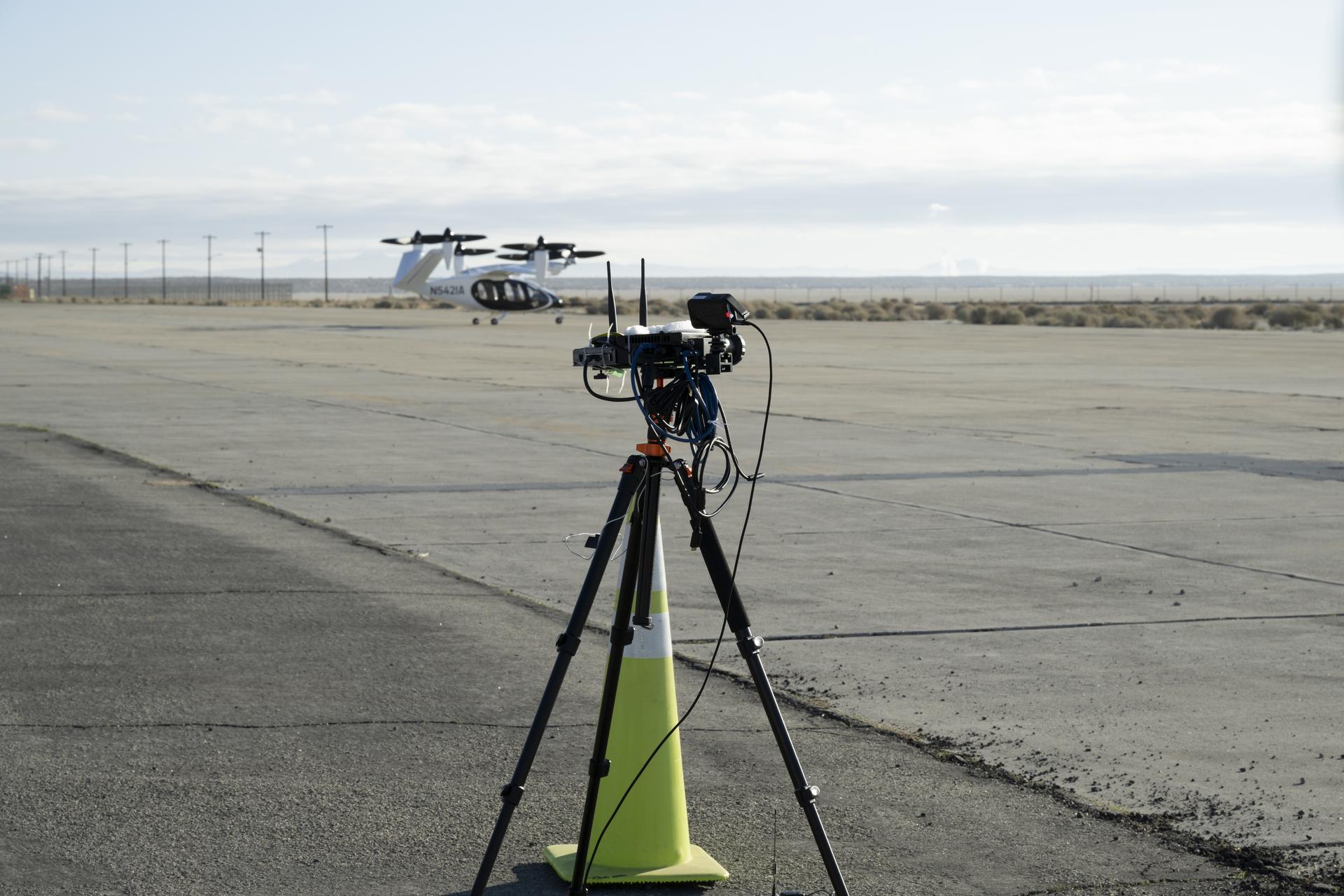3 min read
Preparations for Next Moonwalk Simulations Underway (and Underwater) One of several NASA distributed sensing ground nodes is set up in the foreground while an experimental air taxi aircraft owned by Joby Aviation sits in the background near NASA’s Armstrong Flight Research Center in Edwards, California, on March 12, 2025. NASA is collecting information during this study to help advance future air taxi flights, especially those occurring in cities, to track aircraft moving through traffic corridors and around landing zones.NASA/Genaro VavurisNASA engineers began using a network of ground sensors in March to collect data from an experimental air taxi to evaluate how to safely integrate such vehicles into airspace above cities – in all kinds of weather.
Researchers will use the campaign to help improve tools to assist with collision avoidance and landing operations and ensure safe and efficient air taxi operations in various weather conditions.
For years, NASA has looked at how wind shaped by terrain, including buildings in urban areas, can affect new types of aircraft. The latest test, which is gathering data from a Joby Aviation demonstrator aircraft, looks at another kind of wind – that which is generated by the aircraft themselves.
Joby flew its air taxi demonstrator over NASA’s ground sensor array near the agency’s Armstrong Flight Research Center in Edwards, California producing air flow data. The Joby aircraft has six rotors that allow for vertical takeoffs and landings, and tilt to provide lift in flight. Researchers focused on the air pushed by the propellers, which rolls into turbulent, circular patterns of wind.
NASA aeronautical meteorologist Luke Bard adjusts one of several wind lidar (light detection and ranging) sensors near NASA’s Armstrong Flight Research Center in Edwards, California, on March 12, 2025, in preparation to collect data from Joby Aviation’s experimental air taxi aircraft. NASA is collecting information during this study to help advance weather-tolerant air taxi operations for the entire industryNASA/Genaro VavurisThis rolling wind can affect the aircraft’s performance, especially when it’s close to the ground, as well as others flying in the vicinity and people on the ground. Such wind turbulence is difficult to measure, so NASA enhanced its sensors with a new type of lidar – a system that uses lasers to measure precise distances – and that can map out the shapes of wind features.
“The design of this new type of aircraft, paired with the NASA lidar technology during this study, warrants a better understanding of possible wind and turbulence effects that can influence safe and efficient flights,” said Grady Koch, lead for this research effort, from NASA’s Langley Research Center in Hampton, Virginia.
Data to Improve Aircraft Tracking
NASA also set up a second array of ground nodes including radar, cameras, and microphones in the same location as the sensors to provide additional data on the aircraft. These nodes will collect tracking data during routine flights for several months.
The agency will use the data gathered from these ground nodes to demonstrate the tracking capabilities and functions of its “distributed sensing” technology, which involves embedding multiple sensors in an area where aircraft are operating.
One of multiple NASA distributed sensing ground nodes is set up in the foreground while an experimental air taxi aircraft owned by Joby Aviation hovers in the background near NASA’s Armstrong Flight Research Center in Edwards, California, on March 12, 2025. NASA is collecting information during this study to help advance future air taxi flights, especially those occurring in cities, to track aircraft moving through traffic corridors and around landing zones.NASA/Genaro VavurisThis technology will be important for future air taxi flights, especially those occurring in cities by tracking aircraft moving through traffic corridors and around landing zones. Distributed sensing has the potential to enhance collision avoidance systems, air traffic management, ground-based landing sensors, and more.
“Our early work on a distributed network of sensors, and through this study, gives us the opportunity to test new technologies that can someday assist in airspace monitoring and collision avoidance above cities,” said George Gorospe, lead for this effort from NASA’s Ames Research Center in California’s Silicon Valley.
Using this data from an experimental air taxi aircraft, NASA will further develop the technology needed to help create safer air taxi flights in high-traffic areas. Both of these efforts will benefit the companies working to bring air taxis and drones safely into the airspace.
The work is led by NASA’s Transformational Tools and Technologies and Convergent Aeronautics Solutions projects under the Transformative Aeronautics Concepts program in support of NASA’s Advanced Air Mobility mission. NASA’s Advanced Air Mobility mission seeks to deliver data to guide the industry’s development of electric air taxis and drones.
Share
Details
Last Updated Apr 17, 2025 EditorDede DiniusContactTeresa [email protected] Flight Research CenterRelated Terms
Armstrong Flight Research CenterAdvanced Air MobilityAmes Research CenterConvergent Aeronautics SolutionsDrones & YouFlight InnovationGlenn Research CenterLangley Research CenterTransformational Tools TechnologiesTransformative Aeronautics Concepts ProgramExplore More
3 min readNASA’s Curiosity Rover May Have Solved Mars’ Missing Carbonate Mystery
Article 3 hours ago 1 min readRecognizing Employee Excellence
Article 8 hours ago 3 min readTesting in the Clouds: NASA Flies to Improve Satellite Data
Article 23 hours ago Keep ExploringDiscover More Topics From NASA
Armstrong Flight Research Center
Humans in Space
Climate Change
Solar System
Read More Details
Finally We wish PressBee provided you with enough information of ( NASA Studies Wind Effects and Aircraft Tracking with Joby Aircraft )
Also on site :
- Country Star Reveals He Soiled Himself Onstage in Major 'TMI' Moment
- ‘He’s got MS-13 tattooed onto his knuckles’: Trump appears to hold up photoshopped image of Abrego Garcia’s hand
- 'Fire Country' Star Stephanie Arcila Goes Inside Gabriela’s Stalker Storyline (Exclusive)

